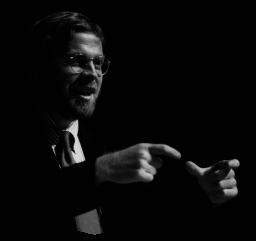
Michael Hawley
piano recital
san anselmo, california
may, 1986

In 1986 I was making a career transition, leaving Lucasfilm in California to embark on a PhD program at the MIT Media Lab. I had also borrowed Mark Seiden's apartment on Clayton Street in the Haight-Ashbury area of San Francisco. And Mark had a nice Steinway “B.” After a few weeks there I found I'd relearned enough music to play an evening concert, and so, in my usual spontaneous way, I threw together a recital program, arranged to use the San Anselmo Presbyterian Church, and persuaded J&B Pianos of San Rafael to loan a wonderful Grotrian concert grand for the occasion. (Grotrian-Steinveg was the parent company that spawned Steinway, and Grotrian continues to make wonderful pianos). Howie Hammerman, an engineer at Lucasfilm, very graciously bent over backwards to make a digital recording (using one of the new Sony video tape decks). I think we've lost the Rachmaninoff/Bach prelude, rondeau and gigue, but the rest of the performance is there --- thanks to Mike Russell, who, many years later, dredged up the bits and transferred them to CD.
Following are a few notes on the music I played.
Johann
Sebastian Bach (1685-1750)
Glenn Gould dismissed this piece as a “monstrosity.” He was crazy. It's an extraordinary piece, big, sprawling, emotional, and quite unique in its character compared to the rest of Bach's music. The opening fantasia is a fire-and-brimstone sermon with blistering runs, daring recitatives, and frequent use of a “weeping” motif (e.g, G G F#). The fugue is built from a long, sinewy melody made of rising and descending chromatic lines. It may be noteworthy that 1725 was also the year Bach's young wife, Maria Barbara, passed away. Coincidence?
Ludwig
van Beethoven (1770-1827)
Beethoven composed the mighty Waldstein sonata around 1804, at roughly age 34, about the same time he sketched the fifth and sixth symphonies, the triple concerto, and the third symphony (the Eroica). But it is the Eroica (op.55) and the Waldstein (op.53) that are sketched in great detail. Initially the Waldstein was to be a big, three-movement work, but Beethoven removed the slow middle movement and published it separately as the Andante Favori (WoO 57). He replaced it with a very short but profound adagio, more as an introduction to the third movement. Count Waldstein, a member of the infamous “illuminati,” befriended Beethoven early on and kept him circulating through the most prestigious salons. In 1791, after Mozart died, Waldstein wrote to Beethoven: “The spirit of Mozart is mourning and weeping over the death of her beloved... With the help of unremitting labor, you shall receive Mozart's spirit.” This sonata, in the majestic key of C major, was dedicated to Waldstein, an expression of Beethoven's gratitude.
Franz
Liszt (1811-1886)
Liszt, on a sort of religious retreat, took up residence at a convent full of silent nuns in Rome, not far from the Vatican. That is where he composed, among other things, the two “Franciscan” legends for piano. The other one depicts Francis of Assisi preaching to the birds. This one tells the tale of the “other” St.Francis, Francis of Paola, walking on the water. Francis of Paula, Liszt's patron saint, was born in Calabria, Italy in 1416, and died in Plessis-les-Tours, France, 1507. He joined the Franciscan sect as a teenager, became famous for working miracles, reading minds, and various other saintly pursuits; and became the tutor and advisor to a series of French kings. His canonization resulted from an incident that occurred in 1464. He wished to cross the Straits of Messina to reach Sicily, but the boatman refused. So, being a saint-in-the-making, he lay his cloak on the water, tied one end to his staff to make a sail, and sailed across with his companions. In Liszt's rendition, a storm blows up nearly swamping the saint, but, miraculously, they survive, and Francis finishes with a prayer on landing safely on mafia soil.
Claude
Debussy (1862-1918)
The tenth and one of the most famous of his preludes, la cathedrale engloutie was probably inspired by the legendary kingdom of Ys (which Lalo expanded into his opera, Le Roi d'Ys). Debussy's story depicts a great cathedral, submerged in ruins beneath the water that mysteriously rises from the waves and into the sparkling light of day, then sinks again into the depths.
Maurice
Ravel (1875-1937)
Ravel's little minuet spells out H-A-Y-D-N (with H=B natural, in the German musical spelling, and Y=D and N=G if you take the 26-letter alphabet mod 12 tones). This little homage was written at about the same time as the orchestration of the famous pavane. But the pavane was actually written as a piano piece much earlier, in 1899 (when Ravel was 24). It is a sort of wistful reminiscence of a graceful little girl in a painting from centuries ago, evoking the delicate little dance steps she might have taken.
Frédéric
Chopin (1810-1849)
The famous ballade in g minor is one of the great pianistic war horses. Sketched in 1831, Chopin completed it in 1835 (age 25!), about the same time as some other big pieces (like the Andante Spianato and Grande Polonaise, some mazurkas, etudes, and preludes).
Me
(1961-)
Some favorite film tunes, chosen just for fun (from Willy Wonka by Anthony Newley, Local Hero by Mark Knopfler, and Star Wars by John Williams), tied together in a loose improvisation.
Michael
Hawley
|